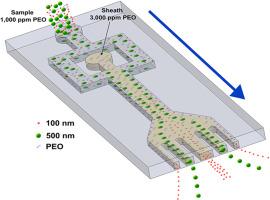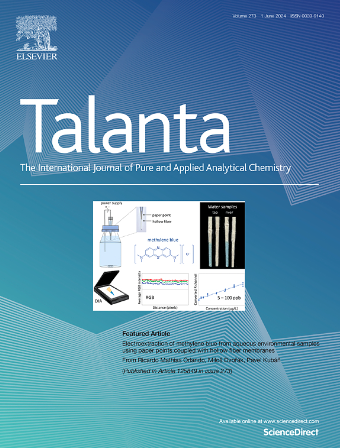聚合物浓度对亚微米颗粒共流粘弹性分离的影响
IF 6.1
1区 化学
Q1 CHEMISTRY, ANALYTICAL
引用次数: 0
摘要
亚微米粒子如细胞外囊泡、病毒和细菌的操作和分离在生物技术和诊断中有着广泛的应用。粘弹性微流体技术已成为非牛顿流体中高分辨率颗粒分选的有力技术。粘弹性共流系统是粘弹性微流体中最流行的颗粒分离设计,已成功用于电动汽车、细菌和癌细胞的分离。然而,目前的研究主要集中在低聚合物浓度粘弹性流体中颗粒的微分迁移,而高聚合物浓度对颗粒迁移和分离的影响仍未得到充分的探讨。在这项工作中,我们研究了100 nm和500 nm颗粒在高聚氧乙烯(PEO)浓度的粘弹性共流微流控系统中的迁移行为。研究了样品流和护套流的PEO浓度、护套与样品流的流量比(FRR)和总流量对颗粒迁移和最终平衡位置的影响。在低PEO浓度下,大颗粒(500 nm)向通道中心快速迁移,小颗粒(100 nm)向通道中心缓慢迁移。相比之下,在特定的高PEO浓度下,出现了一个有趣的相反现象,即小的(100纳米)颗粒快速迁移并集中在通道中心,而500纳米颗粒则保持在侧壁附近。最后,我们成功地将这一现象应用于二元亚微米颗粒混合物的分离,100 nm和500 nm颗粒的分离纯度分别达到88%和87%。这项工作证明了通过调整高聚合物浓度来优化共流系统中基于尺寸的亚微米颗粒分离的潜力。本文章由计算机程序翻译,如有差异,请以英文原文为准。

Effect of polymer concentration in co-flowing viscoelastic separation of submicron particles
Manipulation and separation of submicron particles such as extracellular vesicles (EVs), viruses and bacteria have broad applications in biotechnology and diagnostics. Viscoelastic microfluidic technology has emerged as a powerful technique for high-resolution particle sorting in non-Newtonian fluids. Viscoelastic co-flowing system is the most popular design for particle separation in viscoelastic microfluidics, and has been successfully employed for the separation of EVs, bacteria and cancer cells. However, current studies mainly focus on particle differential migration in viscoelastic fluids of low polymer concentration, and the effects of high polymer concentration on particle migration and separation are still largely unexplored. In this work, we investigate the migration behaviour of 100 nm and 500 nm particles in a viscoelastic co-flowing microfluidic system of high polyethylene oxide (PEO) concentrations. The effects of PEO concentration of sample and sheath flows, the flow rate ratio (FRR) of the sheath to sample flows and the total flow rate on the particle migration and final equilibrium positions were studied. At low PEO concentrations, large (500-nm) particles migrate fast toward the channel centre and small (100-nm) particles exhibit slow migration. In contrast, at specific high PEO concentrations, an intriguing reversed phenomenon appears where small (100-nm) particles migrate fast and focus at the channel centre, while 500-nm particles remain near sidewalls. Finally, we successfully applied this phenomenon for the separation of binary submicron particle mixture and achieved separation purities of 88% and 87% for 100-nm and 500-nm particles, respectively. This work demonstrates the potential for optimising size-based submicron particle separation in the co-flowing system by tuning high polymer concentrations.
求助全文
通过发布文献求助,成功后即可免费获取论文全文。
去求助
来源期刊

Talanta
化学-分析化学
CiteScore
12.30
自引率
4.90%
发文量
861
审稿时长
29 days
期刊介绍:
Talanta provides a forum for the publication of original research papers, short communications, and critical reviews in all branches of pure and applied analytical chemistry. Papers are evaluated based on established guidelines, including the fundamental nature of the study, scientific novelty, substantial improvement or advantage over existing technology or methods, and demonstrated analytical applicability. Original research papers on fundamental studies, and on novel sensor and instrumentation developments, are encouraged. Novel or improved applications in areas such as clinical and biological chemistry, environmental analysis, geochemistry, materials science and engineering, and analytical platforms for omics development are welcome.
Analytical performance of methods should be determined, including interference and matrix effects, and methods should be validated by comparison with a standard method, or analysis of a certified reference material. Simple spiking recoveries may not be sufficient. The developed method should especially comprise information on selectivity, sensitivity, detection limits, accuracy, and reliability. However, applying official validation or robustness studies to a routine method or technique does not necessarily constitute novelty. Proper statistical treatment of the data should be provided. Relevant literature should be cited, including related publications by the authors, and authors should discuss how their proposed methodology compares with previously reported methods.
 求助内容:
求助内容: 应助结果提醒方式:
应助结果提醒方式:


